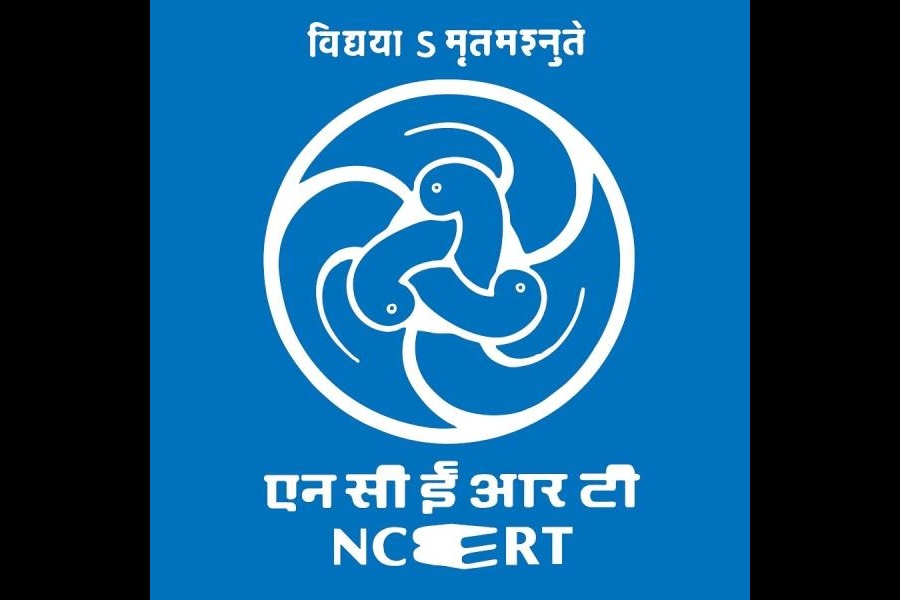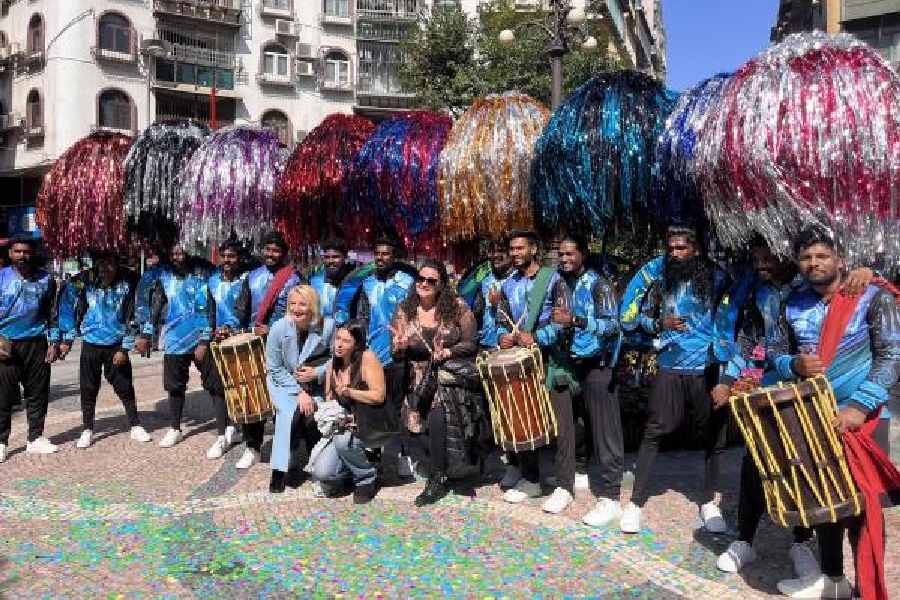 |
| (Above): B.C. Sanyal with his wife Snehalata and great-grand niece. Picture by author. (Right): Portrait of Sanyal painted by artist Noni Borpujari as a tribute. Picture by S.H. Patgiri |
The last days of B.C. Sanyal were hardly a pointer to the fact that his days were numbered. Dressed in crisp white kurta-pyjama, the master-painter still cut a tall figure — a column of light, youth and energy at 101. His clear, intense eyes sparkled with puckish humour, and often the gaze would drift into an inner thought.
He would emerge from his musings, break into a homespun banter peppered with his wry wit. There was in his spirit a kind of dichotomy. Usually gregarious, there was a core in him that was unreachable; a palpable reserve that kept his self in a remote domain.
Dapper as he was, in his herringbone tweed jacket and beret or in his tussar kurtas and woven chadars, he had a distinct monastic quality in his bearing. One could not frame him into a single canvas.
Like his art, he himself came in several shades.
To span a century in a lifetime is uncommon. To live a 100 years to the full, the way Bhabesh Chandra Sanyal did is a rare gift. He took life as it came to him. Born in April 1902 in Dibrugarh, Assam, he traversed the entire breadth of the subcontinent, living life pell-mell, following his impulse, chasing dreams.
His earliest memories of form were those of his widowed mother moulding clay figurines of gods and goddesses to entertain him. He could not have known then that he would spend a lifetime shaping the framework of modern art in India, sculpting the minds of some of India’s finest artists.
The seeds of his imagination were planted in Assam. He spent the first 20 years of his life in the state.
In his memoirs, The Vertical Woman, he revisits his childhood and finds that there was nothing extraordinary “which could fire one’s imagination towards things artistic”.
In fact, in school, it was the drill master who taught him how to draw and to this teacher there seemed no difference between drill and drawing.
But somewhere in the lingering memory of his mother’s fingers shaping clay idols, he inherited a fragment of the great culture of the traditional image-makers of Krishnanagar and Santipur in Bengal (his mother was from Nadia). Growing up in faraway Dibrugarh, he gave in to this inner calling and writes, “Boundless enthusiasm and eagerness consumed me when I watched the making of the Durga image. The rituals of Durga puja may have given me some sense of grace and beauty.”
As a young boy, he remembers seeing a scarcely-clad Naga with his dao on Tikok Hill. “He had a pipe in his mouth and an English felt hat on his head. There a was striking incongruity between his attire and his department, but his body was like a chiselled sculpture, fit for royal robes.” From these descriptions of his earliest memories, one can see the keen tactile sense of the sculptor, nascent in the artist. He said, “From childhood, I had nursed a romantic attraction to sculpture, the craving for stone-carving lay dormant in my heart like a suppressed desire.”
As a painter, apart from the social orientation portrayed in works like The Outcast and The Worker; nature is a recurrent image in several of Sanyal’s canvases. Varying colours, strokes and moods filter through the different phases of his work. While the beauty of Andretta in the Kangra Valley has inspired several of the nature canvasses, the artist himself speaks of Assam as the root of this love for nature.
The grandeur of nature and the wealth of its beauty in Assam have also left a lasting impression on my mind —the mighty Bramhaputra swells into an endless vast sea, awe-inspiring, elemental in character. The faint blue line of the blue mountains on the horizon brings a sense of peace and tranquillity. The deep forests of Assam have to be seen to feel their presence... the vast spread of soothing green of tea plantations is cooling to the eyes.”
In his memoirs, he wishes he had been able to imbibe more of Assam’s culture, “The joyous festivals of the Bohag and Magh Bihu, the poetry and music of the namghar kirtans and the spiritual bliss of the teachings of Sankardev and Madhavdev.” His links with Assam remained strong right through his life and as artist Noni Borpujari says, Sanyal was always there to help and guide young artists from this region.
Moving out of Assam in 1921, the artist went to Serampore College, Bengal. While his elder brother, Dinesh Chandra Sanyal graduated in chemistry from Scottish Church College; B.C. Sanyal made the unconventional choice of joining the Government School of Art, Calcutta in 1923. There was no looking back. His talent and destiny led him to Lahore in 1929. He joined the Mayo School of Art and in 1936 started his own school-cum-studio, Lahore School of Fine Art, which became a hub of creative people. Leaving Lahore with his family during Partition he finally settled in Delhi. After the initial years of struggle in his Gole Market studio, the artist went on to become a key person in Indian art.
Right through his life, he believed in the creative process of art itself and refused to succumb to its commercialisation and the marketing hype of “signatures”. In his years as an art administrator in different institutions he ensured a progressive, congenial atmosphere wherever he was. It is in the effort to support the environment for art and artists in India that he conceived and worked towards creating the Nora Centre for the Arts in Andretta.
In 1984, he was awarded the Padma Bhushan. His memoirs were published by the NGMA, New Delhi, in 1998.
The layered person that he was, Sanyal was not really communicative in the basic sense. His attachments were intuitive, his bonds unspoken. His wife, Snehlata, a theatre person, Leftist intellectual and educationist, was there for him, always the steady supporter.
In 1999, Assam honoured him with the Sankardev Award presented in Guwahati by Prime Minister A.B. Vajpayee. At the ceremony, Sanyal spoke of the need to let go of corruption, hatred and violence and rediscover the goodness in humanity; post-Kargil, he said it was ironic that in 50 years people who lived together as one, in brotherhood, were now sworn enemies spilling blood, declaring war.
Feisty even as he approached a century, he flummoxed the local driving licence authorities by going to renew his driver’s licence at 95! On his 100th birthday, we were up till 2 am savouring the baol sung specially for him. At 101, he was still making plans to visit Andretta.
In the last year, his memories flickered back illuminating vivid vignettes of his childhood. Fascinated by the rising waters of the Bramhaputra in the monsoon, he would wade with other neighbourhood children, into the flooded streets of Dibrugarh looking for river fish. He remembered travelling with his mother on an expedition from Dibrugarh to her home in Nadia, Bengal, journeying partly in a plodding convoy of bullock carts, creaking through swaying fields of rice.
Sanyal’s palette of ideas was brimming even towards the end. That was the extraordinary quality of his spirit. Even in his passing, his energy and art remain with us. Chisel or brush — the definite strokes, the vibrant colours will live on.










